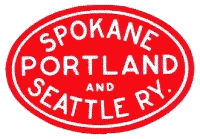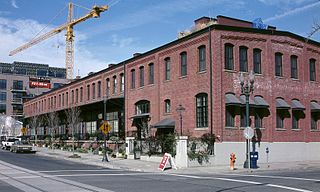
The Empire Builder is a daily long-distance passenger train operated by Amtrak between Chicago and either Seattle or Portland via two sections west of Spokane. Introduced in 1929, it was the flagship passenger train of the Great Northern Railway and was retained by Amtrak when it took over intercity rail service in 1971.

The Salt Lake City Union Pacific Depot is a building on the western edge of downtown Salt Lake City, Utah, United States. Built in 1908–09, it dates back to the more prosperous era in the history of American railroad travel. As Salt Lake Union Pacific Railroad Station, it is listed on the National Register of Historic Places.

The Amtrak Cascades is a passenger train corridor in the Pacific Northwest, operated by Amtrak in partnership with the U.S. states of Washington and Oregon. It is named after the Cascade mountain range that the route parallels. The 467-mile (752 km) corridor runs from Vancouver, British Columbia, through Seattle, Washington, and Portland, Oregon, to Eugene, Oregon.

The Coast Starlight is a long-distance passenger train operated by Amtrak on the West Coast of the United States between Seattle and Los Angeles via Portland and the San Francisco Bay Area. The train, which has operated continuously since Amtrak's formation in 1971, was the first to offer direct service between Seattle and Los Angeles. Its name is a combination of two prior Southern Pacific (SP) trains, the Coast Daylight and the Starlight.

Saint Paul Union Depot is a historic railroad station and intermodal transit hub in the Lowertown neighborhood of the city of Saint Paul, Minnesota, United States. It serves light rail, intercity rail, intercity bus, and local bus services.

Portland Union Station is a train station in Portland, Oregon, United States, situated near the western shore of the Willamette River in Old Town Chinatown. It serves as an intermediate stop for Amtrak's Cascades and Coast Starlight routes and, along with King Street Station in Seattle, is one of two western termini of the Empire Builder. The station is a major transport hub for the Portland metropolitan area with connections to MAX Light Rail, the Portland Streetcar, and local and intercity bus services. The station building contains Wilf's Restaurant & Bar on the ground level and offices on the upper floors. It also has Amtrak's first Metropolitan Lounge on the West Coast, which is reserved for first-class sleeping car and business-class passengers.

The Spokane, Portland & Seattle Railway was a railroad in the northwest United States. Incorporated in 1905, it was a joint venture by the Great Northern Railway and the Northern Pacific Railway to build a railroad along the north bank of the Columbia River. The railroad later built or acquired other routes in Oregon. The SP&S was merged into the Burlington Northern in March, 1970. Remnants of the line are currently operated by BNSF Railway and the Portland and Western Railroad.

Midway is a former Amtrak intercity train station in the Midway neighborhood of Saint Paul, Minnesota, United States. It was last served by Amtrak's daily Empire Builder and, for a time, by the North Star, as well as briefly by the North Coast Hiawatha.

The Pioneer was an Amtrak long-distance passenger train that ran between Seattle and Chicago via Portland, Boise, Salt Lake City, and Denver. Operating from 1977 to 1997, the Pioneer was the last passenger rail route to serve Wyoming, Southern Idaho, or Eastern Oregon.

The Kelso Multimodal Transportation Center is an Amtrak train station located near downtown Kelso, Washington, United States. The station also serves the neighboring city of Longview, which is located just across the Cowlitz River. The station is served by Cascades and Coast Starlight trains. Greyhound Lines provides national and regional bus service, while RiverCities Transit provides local transit. Shuttle vans, taxis and rental cars can also be hired at the station.

The San Bernardino Santa Fe Depot is a Mission Revival Style passenger rail terminal in San Bernardino, California, United States. It has been the primary station for the city, serving Amtrak today, and the Santa Fe and Union Pacific Railroads in the past. Until the mid-20th century, the Southern Pacific Railroad had a station 3/4 of a mile away. It currently serves one Amtrak and two Metrolink lines. The depot is a historical landmark listed on the National Register of Historic Places as Atchison, Topeka and Santa Fe Railway Passenger and Freight Depot.

St. Cloud station is an Amtrak intercity train station in St. Cloud, Minnesota, United States. It is served by the daily Empire Builder on its route connecting Chicago, Illinois to Seattle, Washington and Portland, Oregon. The next stop westbound is Staples while the next stop eastbound is Saint Paul Union Depot.
Rail transportation is an important element of the transportation network in the U.S. state of Oregon. Rail transportation has existed in Oregon in some form since 1855, and the state was a pioneer in development of electric railway systems. While the automobile has displaced many uses of rail in the state, rail remains a key means of moving passengers and freight, both within the state and to points beyond its borders.

The Pacific Northwest Corridor or the Pacific Northwest Rail Corridor is one of eleven federally designated higher-speed rail corridors in the United States and Canada. The 466-mile (750 km) corridor extends from Eugene, Oregon, to Vancouver, British Columbia, via Portland, Oregon; and Seattle, Washington, in the Pacific Northwest region. It was designated a high-speed rail corridor on October 20, 1992, as the one of five high-speed corridors in the Intermodal Surface Transportation Efficiency Act of 1991 (ISTEA).

The Boise Depot is a former train station in the western United States, located in Boise, Idaho. Opened 98 years ago in 1925, it is listed on the National Register of Historic Places (NRHP). At an elevation of 2,753 feet (839 m) above sea level on the rim of the first bench, the depot overlooks Capitol Boulevard and the Idaho State Capitol, one mile (1.6 km) to the northeast.

The North Bank Depot Buildings, in central Portland, Oregon, United States, are a pair of buildings formerly used as a freight warehouse and passenger terminal for the Spokane, Portland and Seattle Railway (SP&S). Formed in 1905, the SP&S was commonly known as the North Bank Road during the period in which these buildings were in use. The Portland buildings' passenger facilities were also used by the Oregon Electric Railway after that railway was acquired by the SP&S. Located in what is now known as the Pearl District, the buildings were listed on the National Register of Historic Places in 1996. They were in use by the SP&S and its successor, Burlington Northern Railroad, from 1908 until the 1980s. Only the east building was used as a passenger station, and this usage lasted from 1908 until 1931.

The Ontario station is a former train station located in Ontario, Oregon, United States that is listed on the National Register of Historic Places as the Oregon Short Line Railroad Depot. It was constructed in 1907 by the Union Pacific Railroad (UP) for its subsidiary, the Oregon Short Line Railroad (OSL), to replace an 1885 OSL depot that had been located just to the south and had been a simple wood-frame structure. The building is made of concrete block cast to imitate stone, and with red brick trim and other ornamental features. The City of Ontario purchased the building from UP in 1996, but as of 1999 the land remained owned by UP and was being leased to the city. The station was added to the NRHP in 1999.

The Denver and Rio Grande Western Depot, commonly referred to as the Rio Grande Depot, is a former train station on the western edge of Downtown Salt Lake City.

The Hood River station is a historic train station in Hood River, Oregon, currently serving the heritage Mount Hood Railroad. The station was listed on the National Register of Historic Places in 1988 as the Oregon–Washington Railroad and Navigation Company Passenger Station. The station was built by the Oregon–Washington Railroad and Navigation Company, a subsidiary of the Union Pacific Railroad, in 1911. Amtrak's Pioneer also used the station and nearby area from 1977 to 1997.

The Portland Subdivision is a railway line in the state of Oregon in the United States. It is owned by the Union Pacific Railroad and runs 185 miles (298 km) from Portland, Oregon, to Hinkle, Oregon. The line runs east-west along the south bank of the Columbia River through the Columbia River Gorge.






















